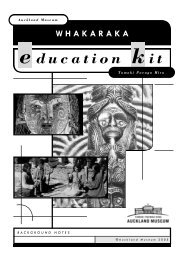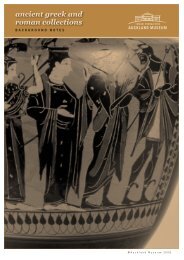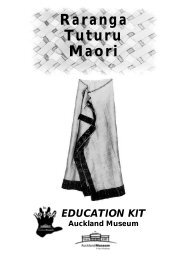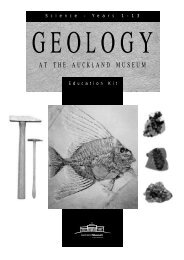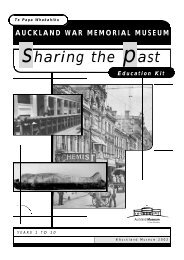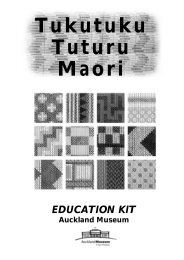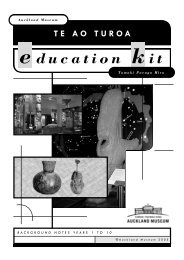Create successful ePaper yourself
Turn your PDF publications into a flip-book with our unique Google optimized e-Paper software.
<strong>Auckland</strong> <strong>Museum</strong><br />
TE AO KOHATU<br />
e ducation k it<br />
YEARS 1- 10<br />
Maori Technology<br />
Te Papa Whakahiku<br />
<strong>Auckland</strong> <strong>Museum</strong><br />
Te Papa Whakahiku<br />
© <strong>Auckland</strong> <strong>Museum</strong> 2001
Te Ao Kohatu<br />
1 Contents<br />
ABOUT THIS RESOURCE:<br />
This resource is designed to support Social<br />
Studies classes of all levels, and may also<br />
be used by teachers of science, history and<br />
technology.<br />
Further resources are available, dealing with:<br />
Te Mahi Kai (Maori Foodgathering)<br />
He Taonga Maori (Maori Treasures)<br />
Te Ao Turoa (Maori Natural History)<br />
Whakaraka (traditional Maori games and pasttimes)<br />
Whakairo Tuturu Maori (carving)<br />
Tukutuku Tuturu Maori<br />
Kowhaiwhai Tuturu Maori<br />
Raranga Tuturu Maori (weaving)<br />
<strong>Auckland</strong> <strong>Museum</strong><br />
Te Papa Whakahiku<br />
About this Resource 1<br />
Booking Information 1<br />
Introduction: 2<br />
Teacher Background: 3<br />
Gallery Activity Sheets: 9<br />
Adult/child interaction is important to maximise your<br />
museum experience. Group leaders need to have<br />
some background knowledge of what the students<br />
are expected to cover and they are advised to participate<br />
in the introduction on arrival.<br />
page<br />
BOOKING INFORMATION:<br />
All school visits to the museum must be booked.<br />
We advise booking 2-3 months in advance.<br />
Numbers:<br />
He Taonga Maori Galleries<br />
90 maximum (including adults)<br />
Sessions Hands-On<br />
35 maximum students.<br />
Adult/child ratio:<br />
Y 1-4 1:6<br />
Y 5-6 1:7<br />
Y 7-8 1:10<br />
Y 9-10 1:30<br />
contents<br />
Booking:<br />
Contact the <strong>Museum</strong> School Bookings Officer at:<br />
Private Bag 92018 <strong>Auckland</strong><br />
Phone: (09) 306 7040<br />
Fax: (09) 306 7075<br />
Introductions and Hands-on Sessions facilitated<br />
by Education Staff are available. Please ask<br />
the School Bookings Officer for more information.<br />
<strong>Auckland</strong> <strong>Museum</strong> Education kits may be downloaded<br />
free at www.akmuseum.org.nz
introduction<br />
<strong>Auckland</strong> <strong>Museum</strong><br />
Te Papa Whakahiku<br />
AN INTRODUCTION TO TE AO KOHAU<br />
Te Ao Kohatu<br />
The Maori who first came to New Zealand had to adapt to a colder climate<br />
with unfamiliar natural resources. Warmer clothes had to be made,<br />
new horticultural techniques had to be developed and food had to be<br />
stored. New materials such as flax and pounamu (greenstone) were readily<br />
taken advantage of.<br />
PACIFIC<br />
LIFEWAYS<br />
EDUCATION<br />
CENTRE<br />
LOGAN<br />
CAMPBELL<br />
GALLERY<br />
MEZZANINE<br />
GALLERY<br />
WEST<br />
GALLERY<br />
PACIFIC<br />
MASTERPIECES<br />
MAORI NATURAL<br />
HISTORY<br />
HUMAN IMPACTS<br />
MATAPUNA<br />
Natural History<br />
Resource Centre<br />
BB’S CAFE<br />
ORIGINS<br />
WILD CHILD<br />
APEC ROOM<br />
MUSEUM STORE<br />
LAND<br />
OCEANS<br />
MUSIC GALLERY<br />
CITY<br />
MAORI TREASURES<br />
DIRECTORS GALLERY<br />
TREASURES & TALES<br />
Discovery Centre<br />
WEIRD & WONDERFUL<br />
Discovery Centre<br />
SPECIAL EXHIBITION<br />
HALLS I & II<br />
FIRST FLOOR<br />
GROUND FLOOR<br />
Introduction 2
Te Ao Kohatu<br />
TE AO KOHATU<br />
Maori Technology<br />
FLAX<br />
The first people to arrive in New Zealand wore<br />
clothes made from the bark of the Aute tree<br />
(paper mulberry). The New Zealand climate was<br />
too cold for this plant to survive and flax<br />
(harakeke) was used as an alternative. Flax had<br />
many other uses including: kete (baskets), whariki<br />
(mats), ra (sails), and taura (rope).<br />
Certain conventions were and still are adhered to<br />
in collecting flax, much of which is to ensure<br />
longevity of the plant. The rito (young shoot in<br />
the center) and the awhirito (two leaves either<br />
side of the rito) are not cut, as it weakens the<br />
plant. Any trimmings and waste material are<br />
returned to the flax plant to rot, helping the<br />
growth of the plant by returning it to papa and<br />
enriching the soil.<br />
The different types of flax plants were used for<br />
different purposes depending on their properties.<br />
The flax leaf itself could be woven, or the<br />
muka (flax fibres) could be used from flax rich in<br />
fibre. The muka was extracted by removing the<br />
outer green layer from the leaf with a mussel<br />
shell.<br />
3 Teacher Background<br />
<strong>Auckland</strong> <strong>Museum</strong><br />
Te Papa Whakahiku<br />
teacher background<br />
TThe Maori who first came to New Zealand had to adapt to a colder<br />
climate with much more marked seasons. Warmer clothes had to be<br />
made and food could no longer be cultivated and collected all year<br />
round. New horticultural techniques had to be developed and food had to<br />
be stored.<br />
Many of the plants that were brought over to New Zealand did not survive<br />
the colder climate and had to be replaced with already existing<br />
plants. New materials such as flax and pounamu (greenstone) were readily<br />
taken advantage of.<br />
Extraction of muka.<br />
rito<br />
awhi rito<br />
Muka could be soaked in water and pounded<br />
with patu muka (flax pounders) to make it soft<br />
before plaiting or weaving. Feathers could be<br />
incorporated into the weaving of muka to make<br />
a feathered cloak. Muka could be dyed using<br />
mud or an infusion of boiled bark. The mud was<br />
chosen for its black or dark gray colour. <strong>It</strong> would<br />
be fed with particular combinations of decomposing<br />
leaves to enrich the colour. The colour was<br />
set by rolling the dyed fibre in hot white ashes.<br />
Flax pounder.
Piupiu are made from strips of flax leaves that<br />
have been dried in the sun. Drying causes the<br />
leaves to curl into the tube-like strands that make<br />
up the piupiu. The black stripes are made by<br />
scraping off the outer part of the leaf to expose<br />
the muka which is then dyed by the mud.<br />
GARDENING<br />
The plants that were brought to New Zealand<br />
and successfully survived were kumara, gourd<br />
(hue), taro and yam (uwhi). Kumara was successfully<br />
cultivated at latitudes well south of its normal<br />
growing range. This was achieved by keeping<br />
the tubers alive in storage pits over the cold<br />
winter months and maximizing the sun’s warmth in<br />
the growing season.<br />
They were planted in<br />
mounds of earth and<br />
Ko.<br />
stones. The stones<br />
absorbed the heat of<br />
the sun, providing<br />
warmth for the growing<br />
kumara.<br />
Timo.<br />
To prepare an area for<br />
cultivation, the scrub was<br />
first burnt and the ashes<br />
used as fertilizer. The<br />
ground was loosened<br />
with ko (pointed digging<br />
sticks) and sand and<br />
gravel was scattered<br />
over heavy clay soils to<br />
break it up. Windbreaks<br />
Ketu.<br />
Piupiu.<br />
<strong>Auckland</strong> <strong>Museum</strong><br />
Te Papa Whakahiku<br />
Te Ao Kohatu<br />
were built to protect the young plants and a<br />
smoke insecticide was created by burning<br />
kawakawa leaves or kauri gum to rid the plants<br />
of caterpillars. Timo and ketu were used to weed<br />
the crops. All gardening utensils were made out<br />
of hard wood such as matai and manuka. They<br />
were lashed together with aka, the tough pliant<br />
stem of climbing plants. Timo were fashioned<br />
from a forked branch and therefore required no<br />
lashings.<br />
The stars and moon were carefully observed for<br />
each stage of cultivation. The appearance of<br />
certain constellations showed the coming of a new<br />
season and indicated when to begin planting or<br />
harvesting.<br />
FISHING<br />
Fishing techniques were already well developed<br />
throughout Polynesia by the time Maori reached<br />
New Zealand. The first settlers brought with them<br />
established technologies including nets, hooks,<br />
lures, spears, traps and dredges.<br />
Fishing lure.<br />
Flax replaced coconut fibres and other plant<br />
material to make fishing lines and nets. Paua shell<br />
replaced mother of pearl shell on fishing lures to<br />
attract fish. Traps were made from flexible<br />
branches such as vines or manuka branches.<br />
Fishing Nets<br />
Fishing nets varied from tutoko - small hand nets,<br />
to kaharoa - huge seine nets more than a kilometer<br />
long and ten meters deep. Kaharoa may have<br />
caught several thousand fish in one haul. The bottom<br />
of the larger nets were weighed down with<br />
mahe (stone sinkers). Whau and houama, particularly<br />
lightwoods, were fashioned into poito,<br />
(floats). Gourds and pumice were also sometimes<br />
used as floats.<br />
Teacher Background<br />
4
Te Ao Kohatu<br />
Fish Hooks<br />
Hooks were fashioned from wood, bone and<br />
shell. Wooden hooks could be made by coiling a<br />
growing branch and securing it so it would continue<br />
to grow in the desired curved form. Once<br />
cut from the tree, the hooks were buried in the<br />
hearth beneath a fire to render them inflexible.<br />
Bone hooks were made by drilling out the central<br />
part of the hook and filing smooth with sandstone.<br />
Mahe -<br />
Sinker.<br />
HINAKI<br />
Hinaki were used to trap eel (tuna). The entrance<br />
of the hinaki narrows like a funnel. Eels could<br />
enter the trap by forcing their way through the<br />
funnel. Once inside, it was difficult for them to<br />
exit the narrow end of the funnel. In the north of<br />
the North Island, they were made of the strong<br />
flexible branches of mangemange (climbing<br />
fern). In the south, mangemange was not available<br />
and stronger traps had to be made for<br />
swifter flowing rivers. Split aerial roots of kiekie<br />
were used.<br />
5 Teacher Background<br />
Making a<br />
bone hook.<br />
a<br />
b<br />
<strong>Auckland</strong> <strong>Museum</strong><br />
Te Papa Whakahiku<br />
Hinaki -<br />
eel trap.<br />
Eels migrating seaward in autumn were directed<br />
into hinaki by barriers (weirs) built of posts driven<br />
into the riverbed.<br />
Taruke<br />
Taruke were used to catch crayfish. Crayfish<br />
would fall through the opening and the flax net<br />
at the mouth of the opening prevented them from<br />
escaping. They were made from young manuka<br />
stems, bent round a supplejack and manuka<br />
frame and tied together with flax and vines.<br />
Taruke -<br />
crayfish pot.<br />
BIRDING<br />
The extensive forests of New Zealand teemed<br />
with bird life. Maori developed birding techniques<br />
that were unknown in the rest of Polynesia.<br />
Methods of catching birds utilized knowledge of<br />
their feeding habits on various trees when flowering<br />
and producing fruit. Domesticated birds<br />
were sometimes used to attract prey to traps.<br />
Some of the snares used included:<br />
Waka kereru<br />
This trap was filled with water and was set out<br />
when the miro berries were in season to catch<br />
kereru (wood pigeon). The berries made the<br />
birds very thirsty and they were attracted to the<br />
troughs of water. If they put their head through<br />
a noose, it tightened when the bird attempted to<br />
fly away.
Taki weka<br />
While the inquisitive weka was attracted to the<br />
bundle of feathers the noose was slipped over its<br />
head.<br />
FOOD STORAGE<br />
Much of the food was collected in the warmer<br />
months and needed to be preserved for winter.<br />
Fish were dried in the sun. The removal of water<br />
ensured bacteria could not survive in the flesh.<br />
Birds were cooked and placed in gourds sealed<br />
in their own fat. Cooking killed any bacteria<br />
present and the fat seal<br />
prevented contamination<br />
by subsequent bacteria.<br />
The gourds would be decorated<br />
with the feathers<br />
of whatever bird was<br />
inside to label its contents.<br />
Decorated gourd.<br />
Kumara, unable to grow<br />
all year round, were<br />
stored in rua kumara - low<br />
roofed storage pits in the<br />
ground. Soil, an effective<br />
<strong>Auckland</strong> <strong>Museum</strong><br />
Te Papa Whakahiku<br />
Waka kereru.<br />
Te Ao Kohatu<br />
insulator, maintained an even temperature necessary<br />
to keep the tubers alive over winter. The<br />
location of the pits were carefully chosen in slopping<br />
ground to ensure good drainage. Once dug,<br />
the pits were disinfected using fire. They were<br />
lined with decaying wood and ferns to absorb<br />
moisture and aid insulation.<br />
HANGI<br />
Hangi are earth ovens that cook food using steam<br />
generated by water and heated stones.<br />
A fire is started in a pit, using slow burning hardwood<br />
such as manuka, kanuka or puriri. Stones are<br />
placed in the fire. These stones are chosen for their<br />
ability to hold heat without shattering. Once the<br />
fire has burnt out, shellfish (if available) are first<br />
placed on the heated stones. They release salt<br />
water to provide steam and flavour. Mats are layered<br />
on next, followed by meat and lastly vegetables.<br />
The food was traditionally wrapped in leaves<br />
of particular plants to add flavour and prevent<br />
drying out. Water is sprinkled over the food to<br />
provide steam. Lastly, topsoil covers the hangi to<br />
insulate the cooking food and prevent loss of steam.<br />
VESSELS<br />
Hue (gourds), patua (bark baskets) and kumete<br />
(carved wooden bowls) were used for storing liquids.<br />
When ripe, the rind of hue becomes very hard<br />
and the inner flesh dries into a spongy matter that<br />
adheres to the inside of the gourd. Small stones<br />
were placed inside and the vessel shaken to loosen<br />
the desiccated flesh from the rind.<br />
Teacher Background<br />
6
Te Ao Kohatu<br />
Hue - gourds.<br />
Patua were made from a single sheet of inner<br />
bark from totara or manuka. The bark was generally<br />
steamed, aiding pliability so it could be<br />
bent into shape. The ends were tied to maintain<br />
the desired form. Apertures were filled with vegetable<br />
gum or clay.<br />
Patua - Bark<br />
basket.<br />
BOILING WATER<br />
Without metal or pottery, Maori did not have the<br />
materials to make containers that could be directly<br />
heated by fire. Water was boiled by placing<br />
stones heated by fire into a vessel filled with<br />
water. Wooden tongs were used to transfer the<br />
heated stones.<br />
MAKING FIRE<br />
Fire was made using a fire plough. Kaurima<br />
(sticks) were rubbed briskly against kaunoti<br />
(grooved battens), producing both sawdust and<br />
heat. When smoke appeared, the charred sawdust<br />
was placed on kindling and blown until it<br />
caught alight.<br />
7 Teacher Background<br />
<strong>Auckland</strong> <strong>Museum</strong><br />
Te Papa Whakahiku<br />
Kaurima and<br />
Kaunoti -<br />
firestick.<br />
OIL LAMPS<br />
Shark oil was used as fuel. <strong>It</strong><br />
was extracted by placing heated stones on<br />
minced shark livers and then placed in shells such<br />
as paua. Clay was used to plug the holes in paua<br />
shells and attach a flax-fibre wick.<br />
Paua lamp with wick.<br />
STONE TOOLS<br />
Chips struck from blocks of obsidian (volcanic<br />
glass) and chert gave sharp edged, ready-made<br />
knives. Sandstone was used as a grindstone to<br />
give a smooth surface and sharpen blades.<br />
Sharp-edged flakes were struck off greywacke<br />
boulders to saw through bone and stone.<br />
Holes were made using a tuwiri (drill) that was<br />
manipulated with two cords. A hard sharpened<br />
stone was used as a drill tip and sand and water<br />
was added as an abrasive to aid the process.<br />
Tuwiri - drill.
Toki (adzes) and whao (chisels) were used for chopping<br />
and carving wood. The blades were made<br />
from fine-grained rock such as argillite, basalt,<br />
greywacke and pounamu (greenstone, jade). Most<br />
stones were first roughly shaped by removing chips<br />
with a hard round rock (hammerstone). The roughly<br />
shaped tool was then ground against sandstone to<br />
give the finish blade. Flax cord was used to lash the<br />
blade on to a wooden handle.<br />
Toki - Adze.<br />
Pounamu was prized amongst all rocks. <strong>It</strong> was<br />
treasured not only for its beauty and rarity, but<br />
also its toughness and the thinness to which it<br />
could be cut, making it perfect for sharp hardwearing<br />
implements and weaponry. Pounamu is<br />
difficult to chip, a property that is ideal for<br />
blades but makes it difficult to fashion. <strong>It</strong> was<br />
first sawn with greywacke before being worked<br />
with sand stone. A pierced gourd filled with<br />
water provided a continuous drip of water to aid<br />
the sawing.<br />
Since so much labour was put into making such a<br />
tool, they were generally passed down from generation<br />
to generation. Pounamu tools and<br />
weapons were most treasured and gained value<br />
through the contact of the great ones of the past.<br />
Fame of a pounamu mere could be so great that<br />
prisoners of war asked to be killed by it.<br />
CARVING<br />
Toki (adzes) were used to roughly shape the outline<br />
of a wooden carving. Whao (chisels) were<br />
then employed for the finer detail. Wooden<br />
structures were lashed together with flax rope.<br />
Red and white ochre mixed with shark oil, provided<br />
paint of the respective colours. Carvings<br />
<strong>Auckland</strong> <strong>Museum</strong><br />
Te Papa Whakahiku<br />
Te Ao Kohatu<br />
could be stained black by soaking them in a rich<br />
black mud or using paint made from charcoal.<br />
Bone and stone were carved using various stones<br />
to chip, saw, drill or file them. (See stone tools).<br />
TA MOKO (TATTOOING)<br />
Uhi, a fine bone comb, was employed to make<br />
perforations in the skin. Blood was wiped away<br />
with wisps of soft flax fibre and pigment was<br />
inserted in the cut groove. Pigment was made<br />
from burning kauri gum, resinous heartwood and<br />
a wheto (vegetable caterpillar). The resultant<br />
soot was moistened into a fine black pigment.<br />
When the face was too painful for chewing, the<br />
person would be feed finely prepared food<br />
through a korere, a carved wooden funnel.<br />
Uhi - Bone toothed comb.<br />
Pigment pot.<br />
Teacher Background<br />
8
Gallery Activity Sheet Y 1-3<br />
MAORI GALLERY (GROUND FLOOR)<br />
1. Tools<br />
Find a tool that would be good for chopping down a tree.<br />
2. Pa Model<br />
Find:<br />
- people chopping a tree to make a canoe<br />
- children flying a kite<br />
- something to catch fish with<br />
3. Fishing<br />
You are going to catch fish for the tribe. Find something you would use to catch a really big fish.<br />
What else could you use to catch fish?<br />
9 Gallery Activity Sheet<br />
Page one<br />
4. Gourd<br />
You are going to collect water for the tribe. Find something that would be good to carry water in.<br />
5. Canoe - Te Toki a Tapiri<br />
This canoe could fit one hundred warriors.<br />
Find something to paddle the canoe.<br />
Find something to scoop water out of the canoe.<br />
<strong>Auckland</strong> <strong>Museum</strong><br />
Te Papa Whakahiku<br />
6. Flax<br />
Maori made many things from flax such as baskets, mats and piupiu (flax skirt). Find some things<br />
made out of flax. Write down some of the names.<br />
_______________________________________________________________________________<br />
_______________________________________________________________________________<br />
7. Feathered Cloak<br />
Find a feathered cloak. What made this cloak warm to wear?<br />
te ao kohatu<br />
MAORI NATURAL HISTORY GALLERY (TE AO TUROA - MIDDLE FLOOR)<br />
1. Gardens<br />
You are going to help work in the kumara gardens. What tools could you use to dig in the ground?<br />
2. Fire<br />
Watch the video on fire. You are going to make a fire for the tribe, how would you make it?<br />
3. Hangi<br />
Find the hangi.<br />
You are going to make a hangi to cook the food for the tribe. First you dig a big hole in the ground.<br />
Then you light a fire in the bottom of the hole. What other things do you put in the hole to make the<br />
hangi?
Gallery Activity Sheet<br />
10<br />
ENTRANCE<br />
4<br />
1<br />
1<br />
3<br />
2<br />
The sons of<br />
Maia-paoaki<br />
Wild Child<br />
The great<br />
act of Maui<br />
Rongo<br />
The trail<br />
of plants<br />
and animals Tamaki Isthmus<br />
The offspring of Rangi and Papa<br />
APEC<br />
Room<br />
Hangi<br />
2<br />
Haumia<br />
3<br />
Computer<br />
Interactive<br />
Umu<br />
TO ORIGINS<br />
GALLERIES<br />
The<br />
river of<br />
eels<br />
Legends of Rata<br />
Flax<br />
Eels<br />
Tane<br />
Tangaroa<br />
Pou<br />
Seabirds<br />
Kauri and the<br />
sperm whale<br />
ENTRANCE<br />
Rocks<br />
Computer<br />
Interactive<br />
5<br />
MAORI NATURAL<br />
HISTORY GALLERY<br />
FIRST FLOOR<br />
Director’s Gallery<br />
7 6<br />
MAORI GALLERY<br />
GROUND FLOOR<br />
te ao kohatu<br />
Gallery Activity Sheet Y 1-3<br />
Page two<br />
<strong>Auckland</strong> <strong>Museum</strong><br />
Te Papa Whakahiku
Gallery Activity Sheet Y 4-6<br />
11 Gallery Activity Sheet<br />
Page one<br />
MAORI GALLERY (GROUND FLOOR)<br />
1. Tools<br />
Find a tool that would be good for chopping down a tree. What is it called?<br />
_______________________________________________________________________________<br />
_______________________________________________________________________________<br />
Find a stone that is very sharp and would be good for cutting flax.<br />
Find a tool that could be used for making holes. How do you think it works?<br />
_______________________________________________________________________________<br />
_______________________________________________________________________________<br />
Find some holes that were made with it.<br />
2. Pa Model<br />
Find<br />
- people collecting stones to make tools<br />
- a canoe being made<br />
- equipment to catch fish<br />
<strong>Auckland</strong> <strong>Museum</strong><br />
Te Papa Whakahiku<br />
What is being done to the fish to preserve them over winter so they don't rot?<br />
_______________________________________________________________________________<br />
3. Fishing<br />
Draw something used to trap fish. What is it called?<br />
Describe how it works and what it was made from.<br />
__________________________________________<br />
__________________________________________<br />
__________________________________________<br />
__________________________________________<br />
__________________________________________<br />
__________________________________________<br />
4. Birding<br />
Draw a bird trap, name it, describe how it works and<br />
what it was made from.<br />
__________________________________________<br />
__________________________________________<br />
__________________________________________<br />
__________________________________________<br />
__________________________________________<br />
__________________________________________<br />
te ao kohatu
Page two<br />
te ao kohatu<br />
<strong>Auckland</strong> <strong>Museum</strong><br />
Te Papa Whakahiku<br />
Gallery Activity Sheet Y 4-6<br />
5. Gourd<br />
Gourds were used to store birds in.<br />
How was the gourd decorated to show what bird it contained?<br />
_________________________________________________________________<br />
What else could a gourd be used for? __________________________________<br />
_________________________________________________________________<br />
_________________________________________________________________<br />
6. Buildings<br />
Maori did not have metal, so there were no nails or screws to hold the buildings together. Look at<br />
the buildings and canoe. How are they held together?<br />
_______________________________________________________________________________<br />
What other things in the gallery have been made out of flax? _____________________________<br />
_______________________________________________________________________________<br />
MAORI NATURAL HISTORY GALLERY (TE AO TUROA - MIDDLE FLOOR)<br />
1. Kumara storage pit<br />
Kumara were stored in pits in the ground over winter.<br />
What stops the rain from entering the pit? _____________________________________________<br />
What was used as bedding to stop the kumara getting too cold and dying?<br />
_______________________________________________________________________________<br />
2. Fire<br />
Watch the video on fire. How did Maori make fire? ____________________________________<br />
_______________________________________________________________________________<br />
What was used for lighting at night? _________________________________________________<br />
3. Hangi<br />
What heats the hangi? ____________________________________________________________<br />
What covers the hangi to keep the heat in? ____________________________________________<br />
4. Flax<br />
Flax was very important to Maori. Find some things it was used for.<br />
Inside a flax leaf there is something that looks like hair, called muka. Find some muka. What can<br />
muka be used for? _______________________________________________________________<br />
_______________________________________________________________________________<br />
5. Making stone tools<br />
Stone tools were made sharp by rubbing them on a rough stone called sandstone. Find a big piece<br />
of sandstone that has big grooves in it from sharpening tools.<br />
Find some tools that would have been sharpened on a stone like this one.<br />
Gallery Activity Sheet<br />
12
13 Gallery Activity Sheet<br />
ENTRANCE<br />
5<br />
1<br />
4<br />
1<br />
3<br />
2<br />
The sons of<br />
Maia-paoaki<br />
Wild Child<br />
The great<br />
act of Maui<br />
Rongo<br />
The trail<br />
of plants<br />
and animals Tamaki Isthmus<br />
The offspring of Rangi and Papa<br />
APEC<br />
Room<br />
Hangi<br />
2<br />
Haumia<br />
3<br />
Computer<br />
Interactive<br />
Umu<br />
TO ORIGINS<br />
GALLERIES<br />
The<br />
river of<br />
eels<br />
Legends of Rata<br />
Flax<br />
4<br />
Eels<br />
Tane<br />
Tangaroa<br />
Pou<br />
5<br />
Seabirds<br />
Kauri and the<br />
sperm whale<br />
6<br />
ENTRANCE<br />
Rocks<br />
Computer<br />
Interactive<br />
MAORI NATURAL<br />
HISTORY GALLERY<br />
FIRST FLOOR<br />
Director’s Gallery<br />
MAORI GALLERY<br />
GROUND FLOOR<br />
Gallery Activity Sheet Y 4-6<br />
Page three<br />
te ao kohatu<br />
<strong>Auckland</strong> <strong>Museum</strong><br />
Te Papa Whakahiku
Page one<br />
te ao kohatu<br />
<strong>Auckland</strong> <strong>Museum</strong><br />
Te Papa Whakahiku<br />
Gallery Activity Sheet Y 7-10<br />
MAORI GALLERIES<br />
1. Tools<br />
Find a tool that functioned in a similar way to an axe.<br />
Describe how you think the stone blade was made. ______________________________________<br />
_______________________________________________________________________________<br />
Find a stone that would be good for cutting flax.<br />
Find a tool that was used for making holes. How do you think it worked?<br />
_______________________________________________________________________________<br />
Find some holes that were made with it.<br />
2. Pa Model<br />
What features help defend the pa? __________________________________________________<br />
Why are fish being dried in the sun? _________________________________________________<br />
Find a place where stones are being collected to make tools.<br />
3. Fishing<br />
Draw a fish trap. Name it. Describe how it worked<br />
and what it was made from.<br />
__________________________________________<br />
__________________________________________<br />
__________________________________________<br />
__________________________________________<br />
__________________________________________<br />
__________________________________________<br />
__________________________________________<br />
4. Birding<br />
Draw a bird trap. Name it. Describe how it worked<br />
and what it was made from.<br />
__________________________________________<br />
__________________________________________<br />
__________________________________________<br />
__________________________________________<br />
__________________________________________<br />
__________________________________________<br />
__________________________________________<br />
5. Gourd and bark basket<br />
Gourds were used to store birds in.<br />
The birds were first cooked, why was this important before storing them?<br />
_______________________________________________________________________________<br />
How is it labelled so you can tell what bird is inside? ____________________________________<br />
Find a basket made from bark.<br />
How do you think the bark was softened to bend it in the desired shape?<br />
_______________________________________________________________________________<br />
Gallery Activity Sheet<br />
14
Gallery Activity Sheet Y 7-10<br />
15 Gallery Activity Sheet<br />
<strong>Auckland</strong> <strong>Museum</strong><br />
Te Papa Whakahiku<br />
Page two<br />
te ao kohatu<br />
6. Buildings<br />
Maori did not have metal, so there were no nails or screws to hold the buildings together. Look at<br />
the buildings and canoe. How were they held together?<br />
_______________________________________________________________________________<br />
What other things in the gallery have been made from flax? ______________________________<br />
_______________________________________________________________________________<br />
MAORI NATURAL HISTORY GALLERY (TE AO TUROA - MIDDLE FLOOR)<br />
1. Kumara storage pit<br />
Kumara were stored in pits in the ground over winter.<br />
What was used as insulation and to remove moisture? ____________________________________<br />
Why was it important that the kumara did not become damp? _____________________________<br />
Find the mounds of earth where the kumara are growing nearby. What has been placed in the soil<br />
to absorb the sun's energy and warm the growing kumara?<br />
_______________________________________________________________________________<br />
2. Fire<br />
Watch the video on fire. How did Maori make fire? ____________________________________<br />
What was used as lighting at night? _________________________________________________<br />
3. Hangi<br />
The food in a hangi is cooked using steam. How is the steam made?<br />
_______________________________________________________________________________<br />
The stones used in the hangi were chosen for particular properties.<br />
What properties were important?<br />
_______________________________________________________________________________<br />
What stops heat and steam escaping from the hangi? ___________________________________<br />
4. Flax<br />
The inside of a flax leaf is filled with hair-like fibres. The outer part of the leaf can be scraped off<br />
and the inside fibres can be used. What were these fibres used to make?<br />
_______________________________________________________________________________<br />
Some flax has been dyed. How was it dyed? __________________________________________<br />
_______________________________________________________________________________
Gallery Activity Sheet<br />
16<br />
ENTRANCE<br />
5<br />
1<br />
4<br />
1<br />
3<br />
2<br />
The sons of<br />
Maia-paoaki<br />
Wild Child<br />
The great<br />
act of Maui<br />
Rongo<br />
The trail<br />
of plants<br />
and animals Tamaki Isthmus<br />
The offspring of Rangi and Papa<br />
APEC<br />
Room<br />
Hangi<br />
2<br />
Haumia<br />
3<br />
Computer<br />
Interactive<br />
Umu<br />
TO ORIGINS<br />
GALLERIES<br />
The<br />
river of<br />
eels<br />
Legends of Rata<br />
4<br />
Flax<br />
Eels<br />
Tane<br />
Tangaroa<br />
Pou<br />
Seabirds<br />
Kauri and the<br />
sperm whale<br />
6<br />
ENTRANCE<br />
Rocks<br />
Computer<br />
Interactive<br />
MAORI NATURAL<br />
HISTORY GALLERY<br />
FIRST FLOOR<br />
Director’s Gallery<br />
MAORI GALLERY<br />
GROUND FLOOR<br />
te ao kohatu<br />
Gallery Activity Sheet Y 7-10<br />
Page three<br />
<strong>Auckland</strong> <strong>Museum</strong><br />
Te Papa Whakahiku
AUCKLAND WAR MEMORIAL MUSEUM<br />
The Domain <strong>Auckland</strong><br />
Private Bag 92018 <strong>Auckland</strong> New Zealand<br />
www.akmuseum.org.nz<br />
<strong>Auckland</strong> <strong>Museum</strong><br />
Te Papa Whakahiku



